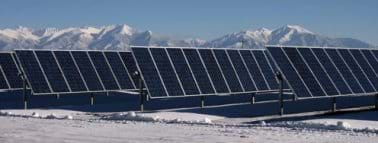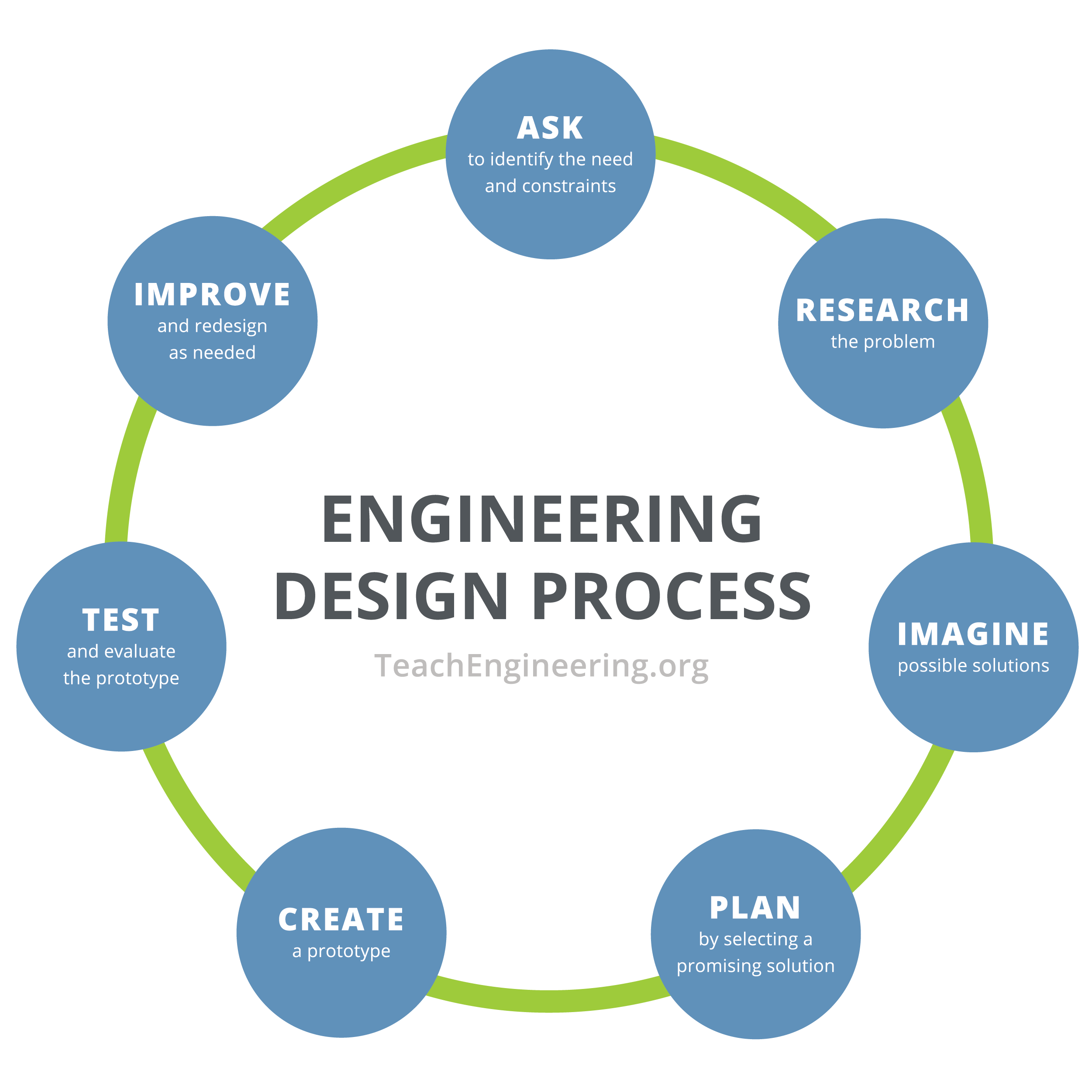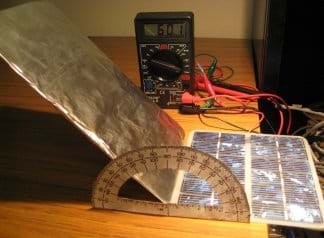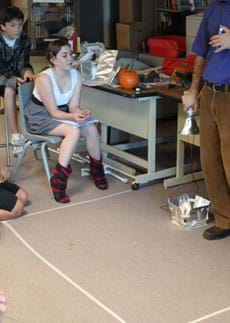Quick Look
Grade Level: 10 (9-12)
Time Required: 3 hours
Total time may be split over a few different periods and may vary, depending on the class and project iterations.
Expendable Cost/Group: US $1.00 In addition, this activity requires some non-expendable (and reusable) items for each group. See Materials List for details.
Group Size: 2
Activity Dependency:
Subject Areas: Data Analysis and Probability, Measurement, Physical Science, Science and Technology
NGSS Performance Expectations:

| HS-ETS1-2 |
| HS-ETS1-3 |
Summary
Students design, build and test reflectors to measure the effect of solar reflectance on the efficiency of solar PV panels. They use a small PV panel, a multimeter, cardboard and foil to build and test their reflectors in preparation for a class competition. Then they graph and discuss their results with the class. Complete this activity as part of the Photovoltaic Efficiency unit and in conjunction with the Concentrated Solar Power lesson.
Engineering Connection
Engineers design and build photovoltaic panels to maximize their efficiency. Engineers work in teams to design and test new ways of concentrating solar radiation onto PV panels and calculate the best way to install panels and reflectors so each PV panel produces the maximum amount of electricity possible.
Learning Objectives
After this activity, students should be able to:
- Explain why concentrated PV systems can increase the output of photovoltaic panels.
- Explain how certain angles between a photovoltaic panel and reflector increase or decrease the panel's power output.
Educational Standards
Each TeachEngineering lesson or activity is correlated to one or more K-12 science,
technology, engineering or math (STEM) educational standards.
All 100,000+ K-12 STEM standards covered in TeachEngineering are collected, maintained and packaged by the Achievement Standards Network (ASN),
a project of D2L (www.achievementstandards.org).
In the ASN, standards are hierarchically structured: first by source; e.g., by state; within source by type; e.g., science or mathematics;
within type by subtype, then by grade, etc.
Each TeachEngineering lesson or activity is correlated to one or more K-12 science, technology, engineering or math (STEM) educational standards.
All 100,000+ K-12 STEM standards covered in TeachEngineering are collected, maintained and packaged by the Achievement Standards Network (ASN), a project of D2L (www.achievementstandards.org).
In the ASN, standards are hierarchically structured: first by source; e.g., by state; within source by type; e.g., science or mathematics; within type by subtype, then by grade, etc.
NGSS: Next Generation Science Standards - Science
| NGSS Performance Expectation | ||
|---|---|---|
|
HS-ETS1-2. Design a solution to a complex real-world problem by breaking it down into smaller, more manageable problems that can be solved through engineering. (Grades 9 - 12) Do you agree with this alignment? |
||
| Click to view other curriculum aligned to this Performance Expectation | ||
| This activity focuses on the following Three Dimensional Learning aspects of NGSS: | ||
| Science & Engineering Practices | Disciplinary Core Ideas | Crosscutting Concepts |
| Design a solution to a complex real-world problem, based on scientific knowledge, student-generated sources of evidence, prioritized criteria, and tradeoff considerations. Alignment agreement: | Criteria may need to be broken down into simpler ones that can be approached systematically, and decisions about the priority of certain criteria over others (trade-offs) may be needed. Alignment agreement: | |
| NGSS Performance Expectation | ||
|---|---|---|
|
HS-ETS1-3. Evaluate a solution to a complex real-world problem based on prioritized criteria and trade-offs that account for a range of constraints, including cost, safety, reliability, and aesthetics, as well as possible social, cultural, and environmental impacts. (Grades 9 - 12) Do you agree with this alignment? |
||
| Click to view other curriculum aligned to this Performance Expectation | ||
| This activity focuses on the following Three Dimensional Learning aspects of NGSS: | ||
| Science & Engineering Practices | Disciplinary Core Ideas | Crosscutting Concepts |
| Evaluate a solution to a complex real-world problem, based on scientific knowledge, student-generated sources of evidence, prioritized criteria, and tradeoff considerations. Alignment agreement: | When evaluating solutions it is important to take into account a range of constraints including cost, safety, reliability and aesthetics and to consider social, cultural and environmental impacts. Alignment agreement: | New technologies can have deep impacts on society and the environment, including some that were not anticipated. Analysis of costs and benefits is a critical aspect of decisions about technology. Alignment agreement: |
Common Core State Standards - Math
-
Reason abstractly and quantitatively.
(Grades
K -
12)
More Details
Do you agree with this alignment?
-
Use appropriate tools strategically.
(Grades
K -
12)
More Details
Do you agree with this alignment?
-
Reason quantitatively and use units to solve problems.
(Grades
9 -
12)
More Details
Do you agree with this alignment?
-
Summarize, represent, and interpret data on a single count or measurement variable
(Grades
9 -
12)
More Details
Do you agree with this alignment?
International Technology and Engineering Educators Association - Technology
-
Students will develop an understanding of the attributes of design.
(Grades
K -
12)
More Details
Do you agree with this alignment?
-
Students will develop an understanding of engineering design.
(Grades
K -
12)
More Details
Do you agree with this alignment?
-
Students will develop abilities to apply the design process.
(Grades
K -
12)
More Details
Do you agree with this alignment?
-
Students will develop an understanding of the effects of technology on the environment.
(Grades
K -
12)
More Details
Do you agree with this alignment?
-
Energy resources can be renewable or nonrenewable.
(Grades
9 -
12)
More Details
Do you agree with this alignment?
-
Apply a broad range of making skills to their design process.
(Grades
9 -
12)
More Details
Do you agree with this alignment?
-
Develop a plan that incorporates knowledge from science, mathematics, and other disciplines to design or improve a technological product or system.
(Grades
9 -
12)
More Details
Do you agree with this alignment?
State Standards
Colorado - Math
-
Reason quantitatively and use units to solve problems.
(Grades
9 -
12)
More Details
Do you agree with this alignment?
-
Summarize, represent, and interpret data on a single count or measurement variable.
(Grades
9 -
12)
More Details
Do you agree with this alignment?
Colorado - Science
-
Use appropriate measurements, equations and graphs to gather, analyze, and interpret data on the quantity of energy in a system or an object
(Grades
9 -
12)
More Details
Do you agree with this alignment?
-
Evaluate the energy conversion efficiency of a variety of energy transformations
(Grades
9 -
12)
More Details
Do you agree with this alignment?
Materials List
Each group needs:
- mini PV panel ($10-30; available online; do a product search for "small solar panel" or see the Solar Panel Source Information attachment in the Photovoltaic Efficiency unit)
- alligator clips
- wires
- multimeter ($10; available online; see the Solar Multimeter Source Information attachment in the Photovoltaic Efficiency unit) (experiment can be run with either one or two multimeters per group, see Procedure section for details)
- cardboard, a 2 ft x 2 ft (.6 m x .6 m) piece
- scissors
- protractor (or use attached Protractor Printout, two per sheet, print out and cut apart)
- aluminum foil
- Investigation Worksheet, one per person
- (if not using the sun as light source) clamp or desk lamp with 100W incandescent bulb (~$8; best for each group to have their own, but teams can share if necessary)
To share with the entire class:
- duct or masking tape
- paper and pencils, for drawing and sharing design ideas
Note: The non-expendable items (mini PV panels, multimeters, wires with alligator clamps, lamp and light bulb) are reusable for the entire four-lesson unit, as well as other projects.
Worksheets and Attachments
Visit [www.teachengineering.org/activities/view/cub_pveff_lesson04_activity1] to print or download.Pre-Req Knowledge
Familiarity with the material covered in the associated lesson and curricular unit. Ability to read data from charts, and record and graph data on scatter plots.
Introduction/Motivation
Throughout this unit, we have learned about the importance of maximizing the efficiency of photovoltaic panels and different ways engineers maximize power output. Today, we're going to design, build and test small planar reflectors, and examine how reflecting and concentrating light onto a PV panel can help increase its power output. PV panels are expensive, so it is important to maximize the amount of power each individual panel produces. We can do this by increasing the amount of solar radiation that hits the panel.
Engineers rarely make the best designs on their first try. In this design project, your team will test your designs many times to see if you can find a way to make your design a little better each time. But, you cannot test forever; so as in all engineering projects, you have a time constraint, and when that time is up, your design will be tested as it is.
Each group has access to all the materials and tools needed to test their designs. Make sure to test different aspects of the designs individually before creating a final reflector design. For example, you may want to test different reflector angles, or test what happens if the foil is more or less crinkled. You may want to experiment with different reflector shapes, or see what happens if you curve them. You are completely free to be creative with your designs, as long as you stay within the material and time constraints. In the end, you want to have the design that creates the highest increase in the current output of the PV panel.
For the final design competition, we will use the same light, same panel and same placement for all reflector designs. This means that you must design your reflector systems so that they are not attached to a specific PV panel, but are free standing. Your designs also must let the PV panel lie flat on the ground; do not create a design that lifts the panel in any way.
During the competition, apply your new knowledge of solar reflecting techniques by guessing the current output of each panel and reflector system before it is tested. After a group presents their design, guess the current output you think it will create, and record this value on your worksheet. Your goal is to have the most accurate estimates, showing that you are now an engineer who understands the basics of how solar concentration systems work.
Procedure
Background
It is important to test the lamps, multimeters and solar panel devices before attempting to conduct the final design competition. The multimeters have many different settings that should be understood; this information can easily be found online or in the multimeter manual. For this experiment, DC current is measured. The exact current setting to use depends on the power of the light, efficiency of the panels, and distance between the panel and light. You want the setting that gives the most accuracy in measurement for comparing the reflector designs.
It is also important to measure the current output of the panel before each reflector design is tested. The current is sensitive to the light intensity, which may change slightly over time as the light warms up, or be affected by light through windows. The intensity can easily be disturbed by moving the panel, so it is important to try to minimize this throughout the competition by taping the panel to the floor or outlining exactly where it should be placed.

When conducting the competition, it is helpful to gather all the students around the area where the panels are being tested so they can clearly see the designs. Placing the panel on the floor and clamping the lamp directly above it on a desk is one potential set-up (see Figure 2), but it is important to make sure that students do not bump or move items during the experiment. Having each group give a short presentation on their design before testing is a great way for them to give other students insight into their design, and allowing audience questions stimulates interaction among all students.
To find solutions to real-world problems, engineers follow the steps of the engineering design process. See image above for the steps. See more about the engineering design process at https://www.teachengineering.org/engrdesignprocess.php
Before the Activity
- Gather materials.
- Make copies of the Investigation Worksheets.
- Test the panels and multimeters to make sure all items are working properly.
- (Do this in advance or while students are creating/testing their designs.) Set up a final competition testing area. Place a lamp on a desk about one meter above the floor. Use tape to mark off an area that students are not permitted to cross so that the lamp is not moved during the final testing (see Figure 2). Also mark an area where the panel is to be placed.
With the Students
- As necessary, review the associated lesson concepts to make sure students understand the theory behind this activity.
- Conduct the Introduction/Motivation section with the students.
- Give the students an opportunity to ask any questions they may have on the process for the activity and competition.
- Divide the class into groups of two students each.
- Review the main steps of the engineering design process: brainstorm, design, analyze, build, test and re-design to improve. Then discuss the project constraints and requirements (real-world engineering design projects have constraints and requirements):
- Set a project time limit.
- Limit the amount and size of materials.
- Aluminum foil must be wrapped on the cardboard; it cannot be used separately. The purpose of the foil is to provide a reflective surface for the sturdy cardboard.
- During the final test, the reflector must stand up on its own without a student holding it.
- Have teams brainstorm and draw design ideas.
- Have the groups make plans for testing a few aspects of their designs. (Test only one variable at a time.)
- Give groups time to gather materials and tools for testing.
- Have the students gather the allotted materials and begin designing and experimenting with their designs. (Guide students in applying steps of the engineering design process. Are they brainstorming as a team, creating viable designs, testing them, and improving them? Make sure students understand that a design can be tested and then changed in big or small ways and this is called design iteration.) Figure 1 shows an example set-up to test how the angle of a simple planar reflector system affects the current output of the solar panel. Students can also bend and change other aspects of the reflector to find the design they believe will work the best.

Figure 1. Example student practice test of a simple planar PV reflector system. - Keep students on task to meet the deadline for completing their final reflector designs.
- Make sure the final competition testing area is set up, as described in the Before the Activity section (see Figure 2).

Figure 2. Example a solar reflector design final competition testing area. - Bring the students together and review the process for conducting the final design (see the Introduction/Motivation section for some description).
- Hand out the worksheets for the students to record data from the experiments and make their current output estimate for each group.
- Have the first team present. Have each group give a short presentation on their design before testing, and answer a few questions posed by other students.
- Measure the current output of the panel. Then turn off the lamp.
- Tell the students: "Apply your new knowledge of solar reflecting techniques by guessing the current output of each panel and reflector system before it is tested. After a group presents their design, guess the current output you think it will create, and record this value on your worksheet. Your goal is to have the most accurate estimates, showing that you are now an engineer who understands the basics of how solar concentration systems work." Give students time to record data on the panel and make their current estimate.
- Have a few students share their estimates with the entire class. (This helps keep students interested and engaged.)
- Place the reflector over the PV panel and turn on the lamp. (Drum roll is optional.)
- Have students record the current output on their worksheets.
- Repeat steps 14 through 19 for all groups. Make sure students do not bump or move items during the competition.
- Have the students complete the calculations on their worksheets.
- Discuss the results of the competition as a class and ask the students to describe what they have learned from this activity.
Vocabulary/Definitions
concentrated photovoltaic system: (CPV) A system designed to concentrate sunlight onto a PV panel or series of panels in order to increase their power output.
design iteration: An improvement in the design due to testing and redesigning.
irradiance: Power per unit area of solar energy hitting a surface.
planar reflector: A reflective panel used to reflect sunlight in order to increase the power output of a photovoltaic panel.
Assessment
Pre-Activity Assessment
Think, Write, Swap: Assess student comprehension by having each student individually write his/her answers to the following questions:
- Why would an engineer design, build and test a concentrating PV system?
- What is a planar photovoltaic reflector?
- What sort of materials would be the best for designing a reflector?
Have students swap papers with another iu1student and discuss whether their answers are similar or different. Then ask several students to share their answers with the class.
Activity Embedded Assessment
Process Explanation: Talk with each group as they work on their experiment set-ups to be sure they understand the concepts and are correctly recording data. Let teams who have their experiments set up correctly visit and help other groups with their set-ups.
Post-Activity Assessment
Graphing: Have students graph and discuss their results with the class.
Group Presentations: Have each group present their experimental results and final designs in a brief presentation to the class before the final competition testing.
Investigating Questions
- What is the best angle to place reflectors?
- What other factors do you think affect the ability of a reflector to improve the current output of a panel?
- How do you think the current output would be affected if your reflector system were used on a stationary panel on a roof as the sun changes position in the sky?
Safety Issues
Encourage students to be gentle and careful with the solar panels and equipment.
Be aware that the lamps can become very hot when on.
Troubleshooting Tips
If you go outside, adjust the multimeters to a higher current setting to account for the brightness of the sun. (The 10A setting may require adjusting the position of the positive lead.) If you remain inside, use incandescent lamps for this activity, not CFLs.
Activity Extensions
Promote functionality and creativity. If time permits, have students create a commercial or marketing strategy for their concentrator in which the engineering and aesthetic features are highlighted.
Activity Scaling
- For lower grades, conduct this activity as a class demonstration, and/or instead of using the multimeter, use small buzzers that change volume with changing current. This way, rather than filling out the worksheet with measurements, students can observe how the loudness of the buzzer increases or decreases as the angle between the solar panel and the reflector is changed or as a reflector is added to the panel. Buzzers are inexpensive ($4) and can be found at electronics and hardware stores such as RadioShack or online at http://www.scientificsonline.com/.
- For upper grades, require more in-depth presentations and explanations of the purpose and theory behind reflectors.
Additional Multimedia Support
For a description of the engineering design process, see https://www.teachengineering.org/engrdesignprocess.php
Subscribe
Get the inside scoop on all things TeachEngineering such as new site features, curriculum updates, video releases, and more by signing up for our newsletter!More Curriculum Like This

Students learn how the total solar irradiance hitting a photovoltaic (PV) panel can be increased through the use of a concentrating device, such as a reflector or lens.

Students learn about the daily and annual cycles of solar angles used in power calculations to maximize photovoltaic power generation. They gain an overview of solar tracking systems that improve PV panel efficiency by following the sun through the sky.

Students learn how the sun can be used for energy. They learn about passive solar heating, lighting and cooking, and active solar engineering technologies (such as photovoltaic arrays and concentrating mirrors) that generate electricity.

Students explore how the efficiency of a solar photovoltaic (PV) panel is affected by the ambient temperature. They learn how engineers predict the power output of a PV panel at different temperatures and examine some real-world engineering applications used to control the temperature of PV panels.
Copyright
© 2009 by Regents of the University of Colorado.Contributors
William Surles, Abigail Watrous, Malinda Schaefer Zarske, Jack Baum, Stephen Johnson (This high school curriculum was originally created as a class project by engineering students in a Building Systems Program course at CU-Boulder.)Supporting Program
Integrated Teaching and Learning Program, College of Engineering and Applied Science, University of Colorado BoulderAcknowledgements
The contents of these digital library curricula were developed by the Integrated Teaching and Learning Program under National Science Foundation GK-12 grant no. 0338326. However, these contents do not necessarily represent the policies of the National Science Foundation, and you should not assume endorsement by the federal government.
Last modified: October 22, 2020










User Comments & Tips